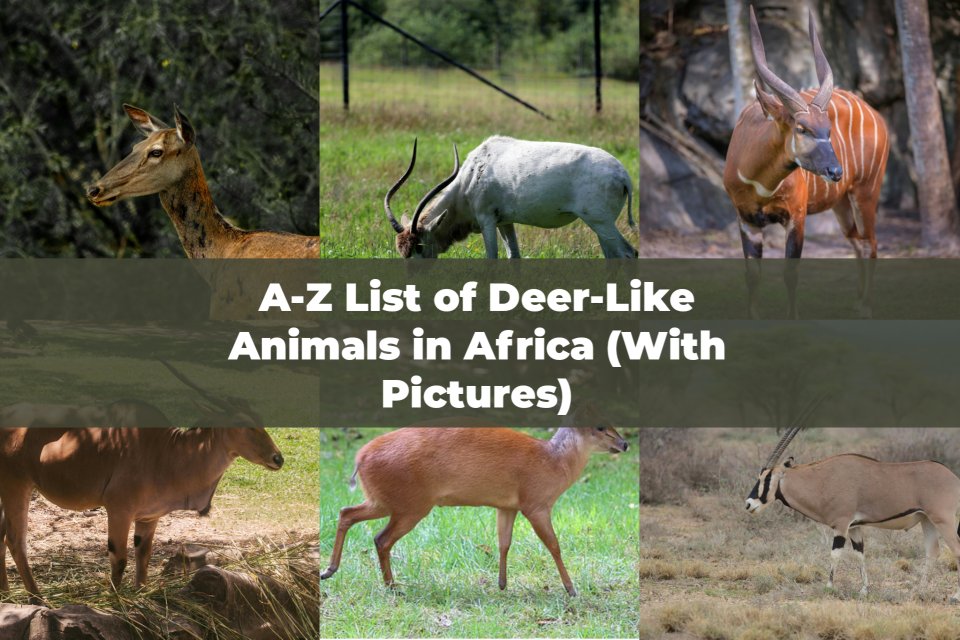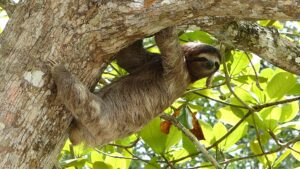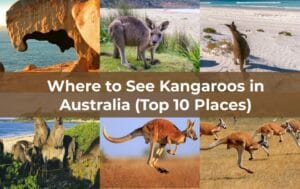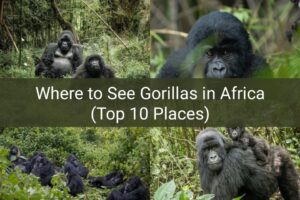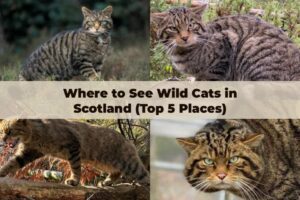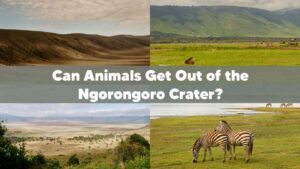Africa is a continent with a lot of wildlife and beautiful landscapes. Although there are different animals in Africa, deer are nowhere to be found.
Africa only has one species of deer called Barbary stag, also known as Atlas deer or African elk. This red deer is found in the mountain forests of Algeria, Tunisia, and Morocco.
Many other deer-like animals can be found throughout Africa. These animals fall under different species of antelopes.
In this article, we will look at the A-Z list of deer-like animals in Africa.
The A-Z List of Deer-Like Animals in Africa
A – Addax

Scientific Name: Addax nasomaculatus
The addax is a deer-like animal that is native to the Sahara Desert in Africa. Addax is also known as the white antelope or the screwhorn antelope.
This antelope species appears to be pale with long, twisted horns that reach up to 85 cm (33 in).

One amazing feature of the Addax is that its coat changes colour depending on the season. During the winter, their hindquarters and legs turn greyish-brown with white, and the hair on the head, neck, and shoulders is brown. In the summer, their coat turns almost completely white or sandy blonde.
The main diet of an addax primarily consists of grasses and leaves of any shrubs, bushes, or leguminous herbs. Since they have adapted to survive in the desert, they can live without water for long periods.
B – Bongo

Scientific Name: Tragelaphus eurycerus
Bongo is another animal that falls under our category of deer-like animals. This antelope species is large and prefers to live in forest regions in sub-Saharan Africa.
Although they can be active during the day, they are considered nocturnal. They seem to possess similar crepuscular behaviour as deers.
Bongos can be identified by their reddish-brown coat with black and white markings, white-yellow stripes, and long spiralled horns.
They are classified as one of the largest forest antelopes in Africa.
B – Bushbuck

Scientific Name: Tragelaphus scriptus
The Bushbuck is a medium-sized antelope that is also known as imbabala. The resemble deers and found across rain forests, montane forests, forest-savanna, and woodland in Africa.
Bushbuck can be found from west Africa towards east Africa, and southern Africa. In Nigeria, Bushbuck can be seen in Cross River National Park, Okomu National Park, and Yankari Game Reserve.
These are the Antelope species often found throughout Nigeria, Benin, Ghana, and other West African countries.
C – Common Eland

Scientific Name: Taurotragus oryx
The Common Eland is the largest antelope in Africa. They are found throughout East and Southern Africa.
Common Elands are also known as the southern eland or eland antelope. They prefer regions with flowering plants, such as grasslands, savannahs, and woodlands.
They can form herds of up to 500 animals in the wild and move together. Since they are not territorial, they are always on the move.
Countries to see Elands in the wild in Africa are Angola, Botswana, the Democratic Republic of the Congo, Eswatini, Ethiopia, Kenya, Malawi, Namibia, Rwanda, South Africa, South Sudan, Tanzania, Uganda, Zambia, Zimbabwe, and many others.
D – Duiker

Scientific Name: Cephalophinae
Duikers are small, brown antelopes that are native to sub-Saharan Africa. They are known to be very shy and live in heavily wooded areas.
Instead of feeding on grass, duikers feed on leaves, shoots, seeds, fruit, and buds. They also eat meat by feeding on insects and carrion if the opportunity presents itself.
Duikers do not have specific times of the day when they are mostly active. They can be diurnal, nocturnal, or both.
In Africa, duikers are found in the tropical rainforests of Central and West Africa. This includes countries like Gabon, Cameroon, and the Democratic Republic of the Congo.
Some duiker species, like the grey duiker, are also found in savannahs and woodlands throughout Africa.
E – East African Oryx

Scientific Name: Oryx beisa
The East African Oryx is also known as the Beisa. They are another dear-like animal that is native to Africa.
This medium-sized antelope has a grey coat with black stripes from their head to their underside. They also have a longhorn.
The black and grey colour pattern on the East African Oryx is unique and makes them stand out from other antelope species.
East African oryx are found in semidesert and steppes, where they feed on grasses, leaves, fruit, and buds. They prefer to move in herds that can reach up to 40 animals.
G – Gerenuk

Scientific Name: Litocranius walleri
Gerenuks are also known as giraffe gazelles due to their unique long necks. This antelope species is known for their long, slender necks and somewhat flat heads.
Just like giraffes, they use their long necks to reach for leaves on trees. Gerenuks prefer to feed on trees, flowers, and fruits, stretching their necks to reach higher branches.

Gerenuks have a darker reddish brown colour on their back. Males can easily be distinguished from females by their lyre-shaped horns.
H – Hartebeest

Scientific Name: Alcelaphus buselaphus
Hartebeests are also known as kongoni or kaama. They are found throughout Africa, where they move in herds of 20 to 300 individuals.
These large antelopes have adapted to survive in savannas and open woodlands where they graze alongside other wildlife like zebras and wildebeest.
Hartebeests can be identified by their elongated forehead, which sometimes contains black markings. Both male and female hartebeests have horns that can reach up to 70 cm (28 in) in length. Other unique features include a short neck and pointed ears.
Hartebeests prefer to live in dry savannas, open plains, and wooded grasslands.
I – Impala

Scientific Name: Aepyceros melampus
Impalas, or rooiboks, as they are called, are one of the most popular antelope species in Africa. They are known for their ability to jump up to 10 feet in the air while running.
Impalas are closely similar in appearance to deer. Females are smaller than males and have no horns.
This antelope species has adapted to both grazing and feeding on fruits and leaves.
K – Klipspringer

Scientific Name: Oreotragus oreotragus
Klipspringers are small African antelopes that are very good at climbing and jumping on difficult rocky terrain.
These antelope species walk on the tips of their black hooves, making it easier to move freely in rocky areas.
Klipspringers also have a unique appearance that makes them stand out. Their olive-yellow coat with grey spots makes a rustling sound when shaken.

You can find Klipspringers in African countries like South Africa, Namibia, Angola, Ethiopia, Somalia, the Central African Republic, Nigeria, and many others.
The name Klipspringers means “rock jumper” in Afrikaans.
L – Lesser Kudu

Scientific Name: Tragelaphus imberbis
Lesser Kudu are another antelope species that are similar to deer. They are characterised by their striking spiral horns and beautiful striped coats similar to the bongo, greater kudu, giant elands, and some others.
Lesser kudus are native to Ethiopia, Kenya, Somalia, South Sudan, Tanzania, and Uganda. In these countries they are found in dry bushland regions with short grasses.
M – Mountain Nyala

Scientific Name: Tragelaphus buxtoni
The Mountain Nyala, also known as balbok, is an endangered species found in the highlands of Ethiopia.
Mountain Nyalas can be identified by their grey to brown coats with two to five poorly defined white strips that go from their back to the underside. They also have rows of white markings on the face, throat, and legs.
N – Nyala

Scientific Name: Tragelaphus angasii
Nyalas, or lowland nyalas, are spiral-horned antelopes that are native to Southern Africa. These middle-sized antelopes have a deer-like appearance.
Nyalas are completely different from mountain nyalas found in Ethiopia. Their habitats include dense lowland woodlands and thickets.
A higher population of Nyalas is found in southern Malawi, Mozambique, Zimbabwe, and eastern South Africa.
O – Oribi

Scientific Name: Ourebia ourebi
Oribis are small antelopes found in grassland and savanna regions in Africa. They are known for their slender bodies and long necks.
This antelope can be identified by their slightly raised back, long neck, and limbs. Their yellowish to rufous-brown coat also makes them stand out in the wild.
Males can be differentiated from females by their thin, straight horns.
Oribis are found in African countries like Nigeria and Senegal in the west, Ethiopia and Eritrea in the east, and southward to Angola and South Africa.
P – Puku

Scientific Name: Kobus vardonii
At the letter P, we have the Puku, a medium-sized antelope that is found in Africa.
This sandy brown-looking antelope is found in the southern Democratic Republic of Congo, Namibia, Tanzania, Zambia, and the Okavango Delta in Botswana.
They prefer wet grasslands close to rivers or swamps.
R – Reedbuck

Scientific Name: Redunca
Reedbucks are reddish-brown antelope that are found in areas with tall grasses and wetlands. There are three species of reedbuck: Bohor reedbuck, Mountain reedbuck, and Southern reedbuck.
Southern reedbucks are found throughout southern Africa in countries like Gabon, Tanzania, and South Africa.
Mountain reedbucks are found in mountainous areas in sub-Saharan Africa, while Bohor reedbucks are native to West and Central Africa.
R – Roan Antelope

Scientific Name: Hippotragus equinus
Roan antelope are among the largest and most powerful antelope in Africa. This antelope got its name from its roan colour.
From afar, the face of Roan Antelope looks like a black mask that is white around the eyes.
Both males and females have long, backwards-curving horns and robust builds.
S – Sable Antelope

Scientific name: Hippotragus niger
The Sable Antelope is another large antelope found in wooded savannas in East and Southern Africa.
They are known for their iconic curved horns and black coats that make them stand out in the wild.
T – Topi

Scientific Name: Damaliscus lunatus jimela
Topis are antelope that are talented runners. They are found in the savannas, semi-deserts, and floodplains regions of Africa.
They can be identified by their distinct reddish-brown coat and lyre-shaped horns. Their speed makes them one of the fastest antelope in Africa.
U – Uganda Kob

Scientific Name: Kobus kob thomasi
The Uganda Kob is a medium-sized antelope found in the savannas of Uganda and South Sudan. This antelope appears on the coat of arms of Uganda.
They can be identified by their reddish-brown coats, almost resembling the impala.
W – Waterbuck

Scientific Name: Kobus ellipsiprymnus
Waterbucks are large antelope found throughout sub-Saharan Africa. Just like many other antelope, they have a unique appearance.
They are called waterbucks because they cannot tolerate dehydration in hot weather. This is why they prefer to live in areas close to sources of water.
Warbucks can thrive in different habitats, from grasslands to forests.
Y – Yellow-backed Duiker

Scientific Name: Cephalophus silvicultor
Yellow-backed Duikers are shy, forest-dwelling antelope known for the distinctive yellow patch on their backs.
They are found in African countries like Senegal, Gambia, the Democratic Republic of the Congo, Uganda, Rwanda, Burundi, and Zambia.
Yellow-backed Duikers are mostly active at night. They are easily stunned by torchlight, and this makes them a target for hunters.
This antelope is listed as near threatened by IUCN.
Z – Zambezi Sitatunga

Scientific Name: Tragelaphus spekii
Zambezi Sitatunga is a subspecies found in southern Africa. Sitatungas are semi-aquatic and prefer areas with swamps or permanent marshes.
They have rubbery, shaggy coats coloured rufous reddish brown. Zambezi Sitatungas also have white facial markings and stripes all over their body, most of which are faintly visible.
It is also important to note that their coat is water-resistant, making it easier to navigate marshes and wetlands.
Zambezi Sitatunga Facts
- Zambezi sitatunga antelope is found along the Zambezi River in southern Africa.
- They are excellent swimmer that escapes predators by diving into water and hiding among reeds.
- Female Zambezi sitatunga do not have horns, only males do.
Conclusion
Although Africa has only one native deer, the Barbary stag, there are still many other animals that are similar to deer. In this article, we have covered the A-Z list of deer-like animals in Africa with pictures.
Africa is home to 72 antelope species, most with unique appearances. They are scattered from desert regions to Savannahs.
Most of these dear-like animals can be found in national parks and reserves throughout Africa, especially in South Africa, Tanzania, Kenya, and Zambia.
FAQs
Are moose in Africa?
No, moose are not found in Africa. They do not exist in places like Sub-Saharan Africa, Australia, and Antarctica.
What is the difference between antelope and deer?
Antelope belongs to the Bovidae family, while deer belong to the Cervidae family. Antelope are native to Africa and Asia, while deer are found worldwide.
What is the fastest antelope in Africa?
The fastest antelope in Africa is the Topi. This antelope can reach speeds of up to 70 km/h (43 mph).
What is the African version of a deer?
There are 72 types of antelope in Africa. The antelope is the African equivalent of a deer, found across savannas, forests, and wetlands. Unlike deer, antelopes have permanent horns (not antlers) and belong to the Bovidae family, not Cervidae.

Hi, I’m Louis Ojibe, and I grew up around wildlife in Africa. I have always been fascinated by animals and nature across the world.
As a child, my parents used to take me to see wild animals like lions, elephants, gorillas, tortoises, and many others at our local zoo.

